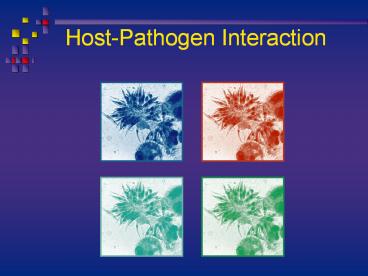Host-Pathogen Interaction - PowerPoint PPT Presentation
1 / 37
Title:
Host-Pathogen Interaction
Description:
... RIG-1/MDA-5 detects dsRNA of virus Modulation of IFN signalling to control virus Formation of the phagolysosome upon ingestion of a microbe Degradation ... – PowerPoint PPT presentation
Number of Views:691
Avg rating:3.0/5.0
Title: Host-Pathogen Interaction
1
Host-Pathogen Interaction
2
(No Transcript)
3
Sites of microbial infection
Mouth
Conjunctiva of eye
Skin
Scratch, injury
Pores, hair Follicles, Sweat glands
Lung
Insect bite
Digestive tract
Urogenital tract
Pathogenic microbes
Normal non-pathogenic microflora
Anus
4
- Pathogens can be successful
- in causing an infection
- They can attach to and penetrate body surfaces
- Ex Schistosoma mansoni
- Pathogens can be introduced by a biting insect
- Ex Malaria, Leishmania, virus, bacteria
- Pathogens can take advantage of preliminary
damage (wound, respiratory tract damage) - Ex Trypanosoma cruzi
5
Vector Reduviid bugs (Triatoma Rhodnius)
a.k.a. Kissing bug
6
However, the Immune Systemhas Natural,
Constitutive Microbial Sensors Utilized to
Rapidly React to Invasive Pathogens.They are
part of the Innate Immune Response and Play
Pivotal Role in the Development of the Adaptive
Immune Response.
7
TLR Roles
ONeill, Luke A.J. Immunitys Early-Warning
System. Scientific American, Jan (2005), 38-45.
8
ONeill, Luke A.J. Immunitys Early-Warning
System. Scientific American, Jan (2005), 38-45.
9
Activation of adaptive immunity by innate
immunity
dsRNA
Unmethylated CpG DNA
LPS
Flagellin
PGN
Cytokines (IL-1, IL-6, IL-12, TNF) Chemokines
(MIP-2, MIP-1a/b)
Lipopeptides
TLR4
TLR3
TLR5
TLR2
TLR9
TLR2
TLR1
Co-stimulatory molecules
CD28
B.7
NF-kB
TCR
Phagocytic receptor
Peptide
MHC
Naive T Cell
Phagosome
Microorganisms
Antigen Presenting Cell
10
Hemozoin A Malarial Metabolic Waste
PfHZ
sPLHZ
Rapid crystalline (0.7-0.9 mm) Size and Shape
similar to PfHZ (see Inset). Bar size is 200 nm.
11
Intracellular Microbial Sensors
- Toll-like receptors
- Membrane Receptor that Sense Extracellular
Microbes - and within phagosome/endosome.
- NOD-Like Receptors, RIG and MDA
- Intracellular Microbial Sensors
- Are Cytoplasmic surveillance proteins with CARD
domain - NOD proteins (Nucleotide-binding oligomerisation
domain) - Two members NOD-1 and NOD-2
- RIG-1 (Retinoid-induced gene 1)
- MDA (Melanoma differentiation-associated gene)
12
CARD domain
- CARD (Caspase-Activating and Recruitment Domain)
- Found in some caspase proteins
- Mediates protein-protein interaction
13
Bouchier-Hayes L and Martin S.J., EMBO (2002)
14
NOD protein structure
NOD-1
N-term
C-term
NOD-2
N-term
C-term
CARD (Caspase-activating and recruitment domain)
NBD (Nucleotide binding Domain)
LRRs (Leucine-Rich Repeats)
15
NOD ligands Peptidoglycan
- Peptidoglycan (PGN)
- Major component of gram cell wall
- Found in thin layer in periplasmic space of gram
- Glycan chains alternating GlcNAc and MurNAc
- linked by peptide bridge
MDP
Meso-DAP
Philpott D.J. and Girardin S.E., Mol Imm (2004)
16
NOD signalling
NOD2
PGN
NOD2
NOD1
NOD1
Transcription
17
NOD-Like Receptors (NLRs)
- NOD1/2 IPAF/NAIP NALP3/ASC
- Bacteria
- PGN PGN
- DAP (meso-diaminopimelic)
- MDP (muramyl dipeptide) MDP
- Salmonella Francisella
- Legionella RNA (PAMP)
- Flagellin Toxins
- Danger-Associated Host Components
- Uric Acid Crystals
- Hemozoin ???
- (metabolic waste)
NOD-1
NOD-2
Meylan et al. Nature July 2006
18
NOD-2 and Crohns disease
- Abnormal NOD-2 expression correlates
- with defective epithelial defense
- NOD-2 expressed in Paneth cells of intestine
- Enteric bacteria induce a-defensin through NOD-2
to kill luminal microbes. - Clinical evidence CD patients have decreased
- a-defensin expression in Paneth cells
19
NOD-Like Receptors, RIG and MDAIntracellular
Microbial Sensors
Summary
- That can detect bacterial and viral ligands
- NOD detects PGN of several bacteria
- Inflammatory response Cell Death (IPAF/NAIP)
- RIG-1/MDA-5 detects dsRNA of virus
- Modulation of IFN signalling to control virus
20
Anti-microbial Functions of Phagocytic Cells
Upon Receptor-Mediated recognition Phagocytosis
and Internalization Phagosome Biogenesis Anti-Mi
crobial Products Pro-Inflammatory Response (last
lecture)
21
Major Players
- Polymorphonuclear leukocytes (PMNs) /
neutrophils - Abundant, short lived
- Elevated number indicate infection
- Professional antigen presenting cells
- Dendritic cells / Langerhan cells (skin)
- Monocytes (blood) ? macrophages (motile or
stationary), which can be tissue specific - Longer lived, lower frequency
22
Underhill and Ozinsky. Annu. Rev. Immunol. 2002
23
Formation of the phagolysosomeupon ingestion of
a microbe
24
Phagosome maturation
Cellular Microbiology, 1999, 1(3)195-203
25
Degradation in the phagolysosome
Phagolysosome
Lysosome
Acid hydrolases
Endosome
Bacteria degradation
26
Phagocytosis and Anti-Microbial Products
Bacteria
Lysosomes
Plasma membrane
Phagolysosome
Phagosome
NAPDH oxidase
O2-
Proteases
H2O2
Nitric Oxide
Ionic strength pH
27
Induction of iNOS Expression
AP-1
iNOS
28
iNOS
29
Resting
Active
gp91phox
p22phox
Heme FAD NADPH
Rac
p47phox
P67phox
30
Reactions Between ROS and RNS
- NO O2- NO2 ONOO-
NONOates S-nitrothiols Nitrite Nitrous Acid
31
Chakravortty and Hensel. Microbes Infect. 2003.
32
Mechanisms of Microbicidal Activity
Polyunsaturated Lipids
DNA
Enzyme Function
33
Evasion
- the act of physically escaping from something
(an opponent or a pursuer or an unpleasant
situation) by some adroit maneuver
Nature 311, 2002 editorial
- Passive
- Active
34
Bacterial defense against phagocytes
Green host Orange bacterial
? v Induction of apoptosis ? X Uptake
v Down-regulate ? v Escape ? X Endosomal
trafficking/ Phagosome maturation ? X Defense
factors ?
35
EVASION MECHANISMS
36
MS150502 3
37
Host Signalling Alteration
Acid phosphatase
Ca2 Channel
IFNg
Ca2Influx
Tyrosine phosphatase
JAK1
LPG
(SHP-1)
Ca2i
JAK2
PTK
PKC
Ser/Thr phosphatase
PMA
DAG
STAT
Protein phosphorylations
PIP2
IP2
Ca2
PLC
G
EXT
INT
FMLP
R
Ca2stores
Cellular functions
- H2O2,O2-
- IL-1
- phagocytosis
- MHC Class II
- c-fos expression
M. Olivier 0295 2































